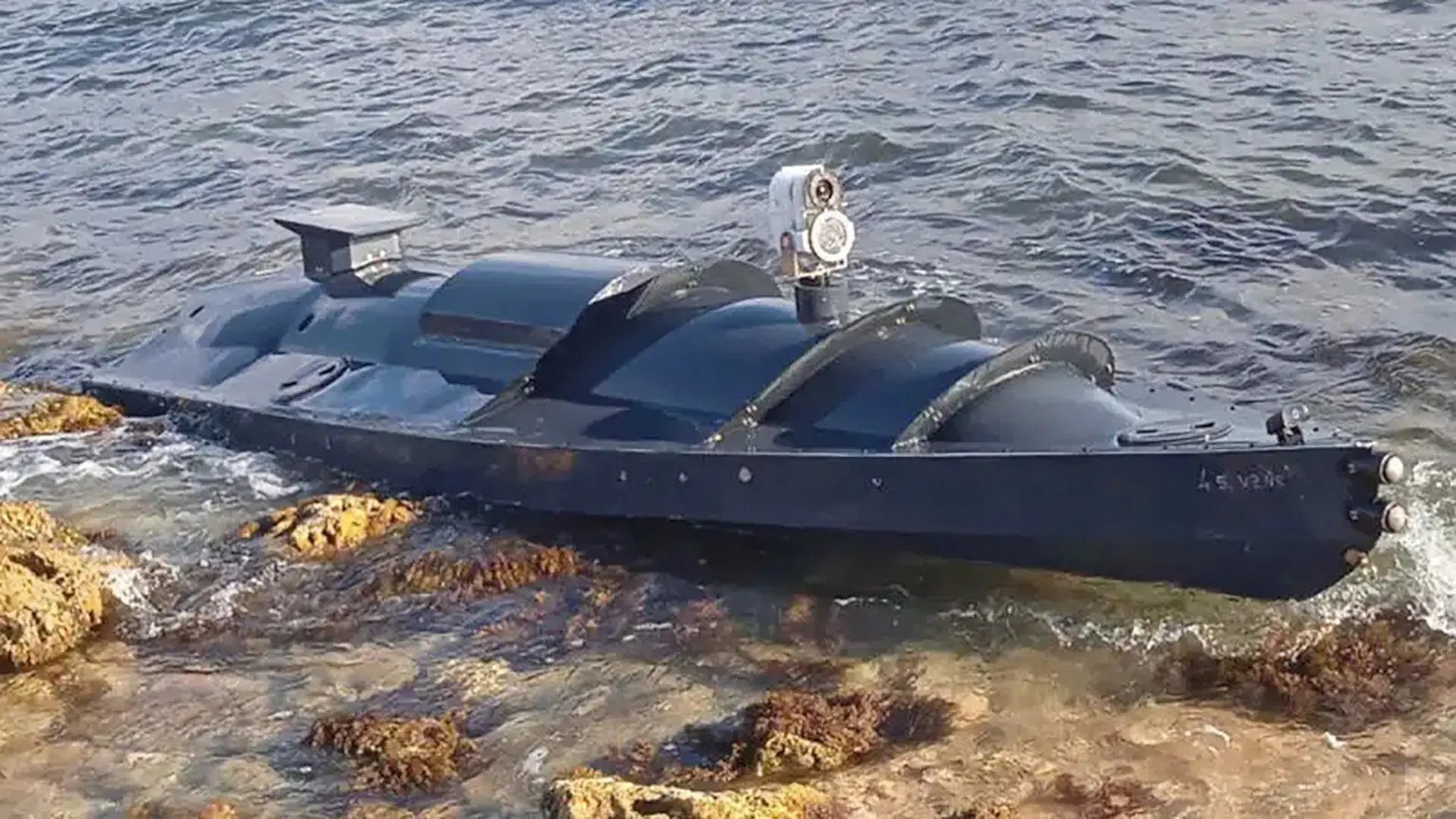We have now gotten our best look yet at Ukraine’s tactical uncrewed surface vessels, or USVs, which were employed in an unprecedented attack on the Russian Navy’s base in Sevastopol on the occupied Crimean Peninsula last month, thanks to an official crowdfunding campaign. Ukrainian authorities say they hope to raise enough funds to buy 100 of the drone boats, which they claim are capable of striking targets as far away as 500 miles, among other missions.
New video footage and images of the USVs were released by the Ukrainian government Friday through its UNITED24 fundraising platform as part of an effort to crowdsource funding for the boats. The USVs, completed and under construction, are 18-foot-long vessels said to be capable of carrying a combat load of up to 400 pounds, with a top maximum speed of about 50 mph. Each USV has a $250,000 price tag that the website says includes a ground-based, autonomous control station, a transportation and storage system, and “a data processing center.” It is unclear exactly what is meant by a data processing center and officials from UNITED24 declined to answer, citing operational security concerns.



Considering that some of the cost includes ancillary items like the transportation and storage system, and maybe the data processing center, the actual cost of just the USVs is likely lower. It really isn’t clear how they would cost that much, but they are handmade with some key enabling technologies. Regardless, they are orders of magnitude cheaper than something like the Naval Strike Missile, for instance, which has an individual price tag of $2,194,000. You can read more about the cost of the U.S. Navy’s ship-launched missiles here.
UNITED24 is an initiative of Ukrainian President Volodymyr Zelensky to raise funds for a wide array of items needed by Ukraine’s military and civilians.
“We must defend the waters of our seas and peaceful cities from Russian missiles launched from ships,” Zelensky wrote Friday on his Telegram channel. “Naval drones will also help unblock the corridor for civilian ships transporting grain for the world.”
Zelensky alluded to previous use of the USVs depicted on the website.
“I am sure that millions of people will support this important area of Ukraine’s defense,” he said. “Everyone has already seen how it works.”


Zelensky’s sentiments were echoed by the head of Ukraine’s Navy.
“Such naval drones have already proven their effectiveness, and can change the situation in the Black Sea significantly,” said Oleksiy Neizhpapa, Vice Admiral, Commander of the Naval Forces of the Ukrainian Navy, in a media release.
Images and video posted on the UNITED24 website show a USV seemingly identical to those captured in images shared by Ukraine of USVs used in its Oct. 29 attack on Russia’s Black Sea fleet at Sevastopol.
While the UNITED24 with claims that attack damaged at least three Russian warships, including the Admiral Grigorovich class frigate Admiral Makarov, reportedly the Black Sea Fleet’s new flagship after the Project 1164 Slava-class cruiser Moskva sank in April, those claims are still unproven.
You can read much more about that attack, and its future implications here. They also appear very similar, if not identical to a USV that washed ashore in Crimea in late September.

When Ukraine’s unmanned suicide drone boat configuration first appeared on a rocky Crimean shoal, it was clear that they would become a major threat to contend with. The jet-black, very low-slung, jet-drive propelled almost kayak-like boat sported multiple camera systems, bow-mounted impact detonation sensors, and what appeared to be a satellite communications antenna, and was in a very different class than what we have seen before for this type of weapon.

It appears now that these are being purpose-built to be fast, maneuverable, hard to detect and engage, and above all else, have beyond line-of-sight control (BLOS) capability. While not uncommon on unmanned surface vessels today, it is new for ones that are intended to be expendable anti-ship weapons in their own right. Though it does appear that given the specifications include both an operational radius and maximum range, some might be deployed to be recoverable as well. It is unclear how many of these USVs may be currently operational.
On the other hand, it’s possible that these could get into a target area autonomously using GPS navigation, then local ‘pilots’ picking them up within line-of-sight to control them for their terminal attack runs. There are big advantages in complexity and retaining the ability to dynamically maneuver and target when it actually matters with such a ‘handoff’ concept of operations. Also, it could act as a fallback for loss of BLOS control. Then again, maybe it is all done with broadband satellite, including man-the-loop-control, which would be a major achievement.




The specifications released on Friday give us a better understanding of how Ukraine could have pulled off such an attack 130 miles from its nearest shoreline.
UNITED24 claims the USVs have an operational radius of up to about 250 miles, a range of up to about 500 miles, a maximum speed of about 50 miles per hour, and a “maximum combat payload” of about 400 pounds. It is unclear what UNITED24 means by maximum combat payload. It could be a combination of various things, including fuel and explosives, and these may be able to carry out other missions beyond strike using other payloads. This is another question we’ve asked them and will add additional details if provided.

They will supposedly be guided from a ground-based ‘autonomous’ control station — likely a point-and-click desktop semi-autonomous configuration — with the help of satellite navigation, or, in the case of GPS-denied areas, an inertial navigation system as well as visually through a video subsystem that also has night vision capabilities. We still don’t know what network they’re using for these, but observers have pointed out in the past that the apparent satellite antenna at the rear looks very similar to the ones available for use with Starlink.

The USVs are claimed to be able to operate autonomously for up to 60 hours, but again, it is unclear exactly what UNITED24 means by this. Again, we have reached out for clarification and will update this story with any additional information.
If these figures are accurate, it would allow the USVs to operate in a wide swath of the western and central Black Sea and easily in reach of Sevastopol.

These USVs, said Neizhpapa, “can participate in long-range maritime reconnaissance and coastal surveillance, escorting and supporting the traditional fleet, convoying merchant ships, zoning in artillery fire, defending our bases and countering amphibious operations.”
The Russian fleet “is constantly terrorizing Ukraine and our cities,” said Neizhpapa. “A fleet of “100 multipurpose surface devices will cement the success of the Navy, following the sinking of the Moskva cruiser and recapturing of Snake Island. They will also give us the opportunity to better protect both the sea and our country’s entire territory.”

Russia has launched more than 4,500 missiles at Ukraine, according to UNITED24, 20% of which came from the sea.
“Ukraine had nothing to oppose these ships, because the Ukrainian fleet lost 80% of its vessels after the occupation of Crimea in 2014,” according to UNITED24.
While that isn’t exactly accurate, — Ukraine has been given RGM-84 Harpoon anti-ship missiles — with a reported operating radius of about up to 250 miles, the USVs also can strike far further than those anti-ship missile systems, which have a range of about 70 miles. They can also execute attacks in an entirely different, unconventional manner.
While Ukraine hopes to raise enough money to build a fleet of USVs to make up for that deficit, it remains to be seen just how much money can be raised and how many will really be built.
Since launching, UNITED24 claims to have received donations from 110 countries, money used to purchase, among other things, nearly 50,000 sets of body armor, nearly 45,000 helmets, nearly 75,000 uniforms, nearly 70,000 sets of tactical underwear, more than 1,400 drones and a helicopter.
We will keep an eye on this project to see just how many USVs are produced and how they are deployed.
Contact the author: howard@thewarzone.com
